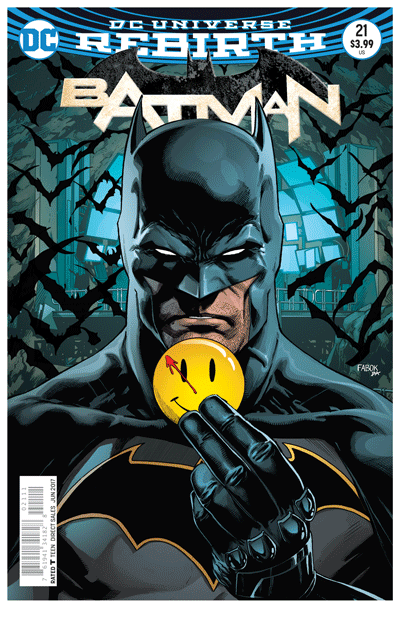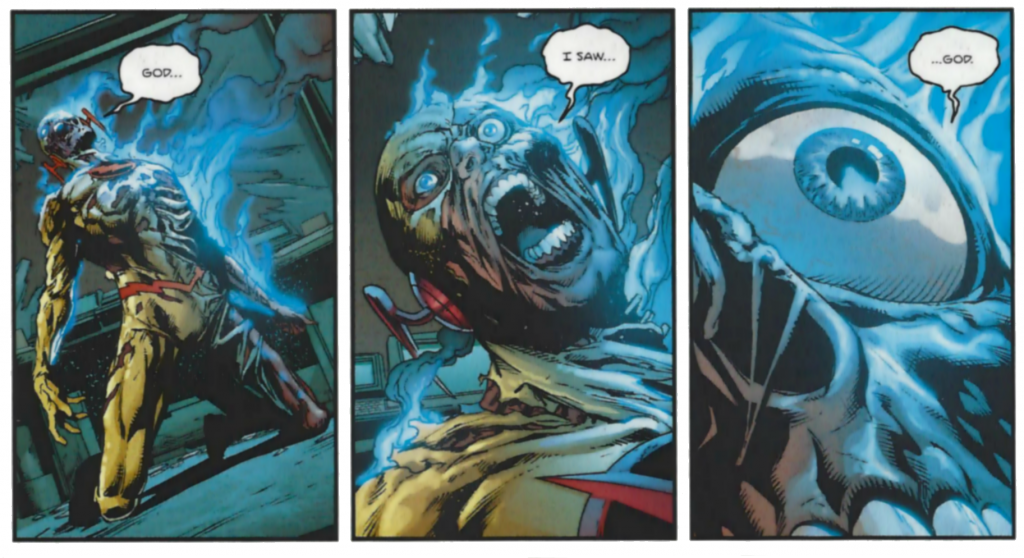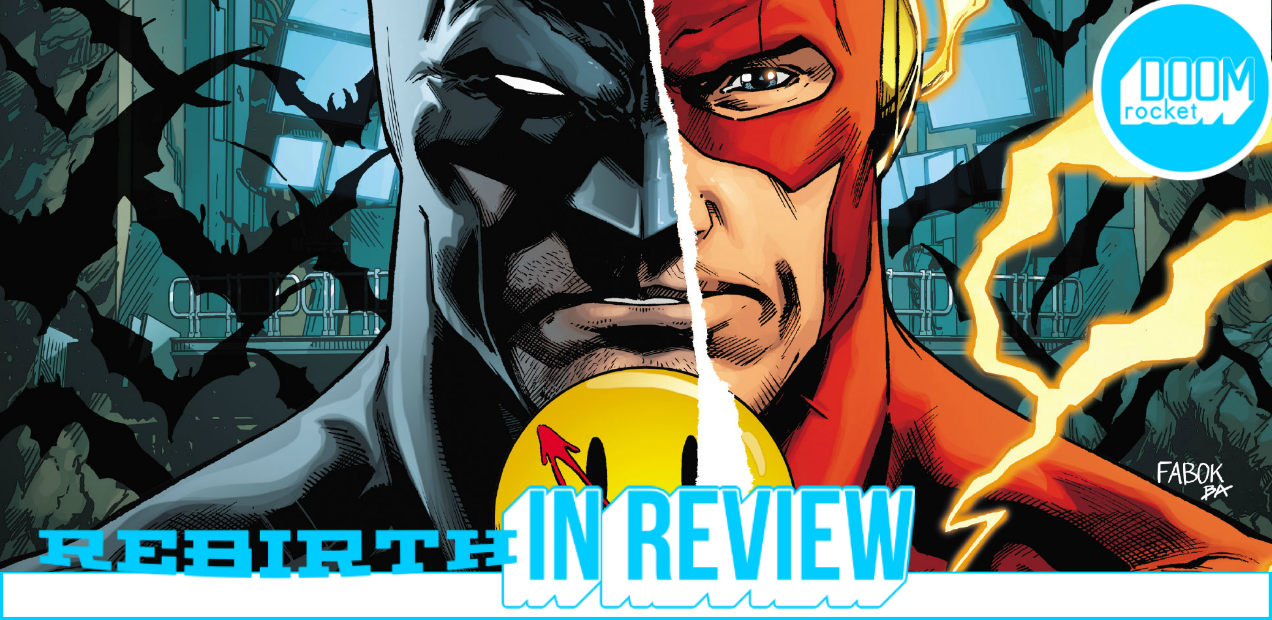By Jarrod Jones. It has been nearly an entire year since DC Comics kicked off its highly successful Rebirth initiative — and one of the more tantalizing mysteries ever to come out of the DCU along with it.
Batman #21 marks the first chapter of “The Button”, a mystery that’s really just about a button with some schmutz on it, if we’re being honest with each other. But this particular button has had tongues wagging over the implications that come with it ever since the publication of DC Universe Rebirth #1: will Watchmen join the wider DC continuity? Is Mr. Oz really Ozymandias? Did Dr. Manhattan go off and create the New 52 after the end of Watchmen because he was feeling exceptionally cruel? And perhaps the most pressing question of all: nobody got the okay from Alan Moore on this, did they?
So, in honor of “The Button”, the four-part mystery that unites the two greatest detectives the DCU ever had (with apologies to Ralph Dibny), we’ve decided to try out something new. We’re diving as deep as we can into “The Button”. Because if we’re gonna live in a world where Dr. Manhattan and Superman are sharing the skies, the means darn well better be worthy of the ends.
Let’s take a look at Batman #21. Needless to say, big time spoilers ahead.
 Batman #21
Batman #21
DC Comics/$3.99
Written by Tom King.
Art by Jason Fabok.
Colors by Brad Anderson.
Letters by Deron Bennett.
Hypnotic, ain’t it. It wouldn’t be a proper DC event without a snazzy lenticular cover, now would it? And since the technology is there to properly dazzle our eyeballs — we’re miles way from the migraine-inducing Villains Month covers three years back — why the heck wouldn’t you want to shell out an extra buck for the visual splendor? And the best bit about this cover? It didn’t cause a spike in the price for the other versions of this issue, thus keeping DC’s “Draw the line at $2.99” promise in check.

Interior page to ‘Batman’ #21. Art by Jason Fabok and Brad Anderson/DC Comics
Quite the reverse. The issue’s biggest “oh, snap” moment was definitely the sudden appearance of Eobard Thawne, the Reverse-Flash, who infiltrated the Batcave under mysterious circumstances to retrieve the eponymous button. (More on that in a bit.) Thawne is a special kind of psychopath, the likes of which Batman has rarely faced against on his own, so the outcome of their first scrape turned out pretty much as you’d expect.
Of course, had Batman not been putzing about watching a bit of hockey (which is an actual plot point to the issue, in true bewildering Batman fashion), perhaps he might have been spared such a thorough thrashing. *Thinks about Reverse-Flash* Then again, probably not.

Interior panel to ‘Batman’ #21. Art by Jason Fabok and Brad Anderson/DC Comics
Dream Girl? That’s certainly what it looks like. I don’t subscribe to the popular “Saturn Girl” theory, particularly when the evidence is all right there in front of us: Nura Nal is no stranger to the nigh-Lovecraftian panic one experiences within the hallways of Arkham Asylum, though how she ended up there in the post-Convergence reality — let alone where the rest of the Legion of Superheroes are hiding at the moment — remains a mystery.
The last time we saw Nura in Arkham was during Geoff Johns’ “The Lightning Saga” which, considering Johns was a primary figure in reshaping the DCU with Rebirth, can’t be a coincidence.
There’s also the matter of this woman’s precognitive powers (she predicts that the issue’s perplexing hockey game will end in murder, which it does). Don’t forget, Nura predicted the wrath of Superboy-Prime in the “Legion of 3 Worlds” storyline, which was also written by — yup — Geoff Johns.
Her prophetic words claim that Superman won’t be able to stop what’s coming, that “the Legion” itself will die in the shadow of this oncoming threat. So it would definitely appear that Rorschach and Silk Spectre aren’t the only DC characters about to make a big debut in the Rebirth continuity.

Interior page to ‘Batman’ #21. Art by Jason Fabok and Brad Anderson/DC Comics
Thomas Wayne, Batman. The first thing that comes from the button’s interaction with Psycho-Pirate’s mask is a rift in the Speed Force, which shows Batman a vision of his father as he was in the Flashpoint reality.
With that comes three total Flashpoint references in Batman #21: we also revisit Thomas Wayne’s letter he sent through realities to Bruce, and Eobard Thawne reflects on his own death at the hands of the elder Wayne (and then goes on to take that enmity out on his son). If nothing else, this shows us that the button has extra-dimensional elements lurking around inside it. It’s been places, that’s for sure.
(Still a weird flippin’ thing that we’re using The Comedian’s button as a gateway device, but whatever.)

Interior page to ‘Batman’ #21. Art by Jason Fabok and Brad Anderson/DC Comics
Minute, Man. The issue’s core gimmick was its countdown sequence, a device employed to compound the dread of having the Reverse-Flash inside Batman’s home with The Flash just seconds away. The countdown spans a single moment, with each second represented within a grid of panels. (I can only imagine Jason Fabok’s face when he realized he’d have to gorgeously render the nine-panel Watchmen layout under deadline.)
Does it work? Well, it does and it doesn’t.
It works in the way a countdown works in a lousy action movie, where seconds last for moments to maximize the dramatics. Some panels feature King’s at-times challenging dialogue, which pushes the limits of the countdown out into the margins. (It’s a nitpick, sure, but when you include ellipses in a line of dialogue that’s only supposed to span the length of a second, that’s some serious guile.) King likes his gimmicks, and the “Countdown” sequence might be one of his most ambitious.

Interior page to ‘Batman’ #21. Art by Jason Fabok and Brad Anderson/DC Comics
“I saw GOD, maaan.” So Eobard Thawne, thanks to events contained in The Flash #19, now remembers the Flashpoint reality clear as day. And boy, is he pissed. What caused the Reverse-Flash’s sudden recollection? “A power… it woke me. It called out. For me. And I am resurrected.” That power drew him straight to the Batcave, looking for trouble.
Now, DC Comics has been lightly peppering its books — primarily The Flash, Titans, Superman, and Detective and Action Comics — with vague references to a higher power lurking outside of the DC Comics timeline. So what do we know about the button?
We know that the lightning that caused Wally West’s trip to the Batcave in DC Universe Rebirth #1 pinned it to the cave’s walls. We know that the blood on the button carries serious radiation within it (which is, y’know, why we see Batman playing with it like it’s no big deal earlier in this issue). And we know it’s from outside time — that’s about it.
We also know by the end of this issue that Eobard has no clue what woke him up. When he finally gets his yellow mitts on the button, he disappears in a flash of blue light. Five seconds later? He’s back, set ablaze in blue flame claiming he just met “god”. He certainly doesn’t give us the impression that he saw this coming, either.
We know that whoever is responsible for the New 52 reality has been making moves for a minute now, and that they may have entered into the DC timeline for some sort of conflict down the road. Most recently in Action Comics #976 we got our first hint that this person — or thing, you don’t know! — is probably stashed away on Mars.
Hmm. Blue flame, time-warping abilities, and possibly a quiet Mars hidey-hole. Now where have we heard that one before…

Interior panels to ‘Batman’ #21. Art by Jason Fabok and Brad Anderson/DC Comics
Slap Shot. Thematically, the hockey game is the issue’s biggest question mark. Was it an effective way to establish Dream Girl’s precognition? Absolutely. Was its brutality reflected in the subsequent fight between Batman and the Reverse-Flash? Yep. (Batman’s kiss-off line: “Overtime“.) And it certainly was… a reason… for The Flash to arrive too late to the Reverse/Bats throw-down. (Judging by King and Fabok’s nine-panel structure, he was nineteen seconds too late.)
But… a murder during a live hockey game? A hockey game that was screened at an asylum for the criminally insane? One that Batman himself just happened to be watching? (Is Batman a hockey fan?) The conceit only fits because it has to. I can’t help but wonder if there could have been a more appropriate way to convey all of this without all the contrivance.
(The biggest groaner came later, when Barry runs into the Batcave all, “Sorry I’m late — thought I’d check out the hockey game to see if I could save that poor man’s life, but I guess he died on the ice from that last blow…” And that last blow, by the way? Batman watched it happen, on television, only to then shut off the screen like nothing just happened.)
It remains to be seen whether the fateful hockey fight between Taylor and Shuster (which, *hyuk*) will have further ramifications in “The Button”. But let’s just pretend that it doesn’t — at least until The Flash #21 tells us otherwise next week.
6.5 out of 10
So what did you think about the first chapter of “The Button”? Sound off in the comments below.













